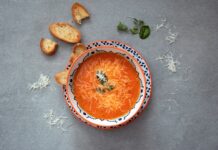Breakfast was served in the courtyard beneath the citadel. Little plates of olives, tomatoes, peppers, white cheese, bread, butter, jam, as well as piping fried eggs in the pan, coffee and tea. I had booked this hotel intentionally for its closeness to the fortress, and sure enough, there it was in all its glory, towering over us in a blue sky.
So naturally, it was our first stop. But we could not enter. There was a sign posted in front explaining that it was closed for tadilat (alterations). And when I pleaded, one of the guards shrugged his shoulders, smiled, and said kısmet.
And those two words seemed to encapsulate our experience in Gaziantep. Everywhere we went, we saw a city under construction and renovation, a city renewing itself, preserving the past and building anew.
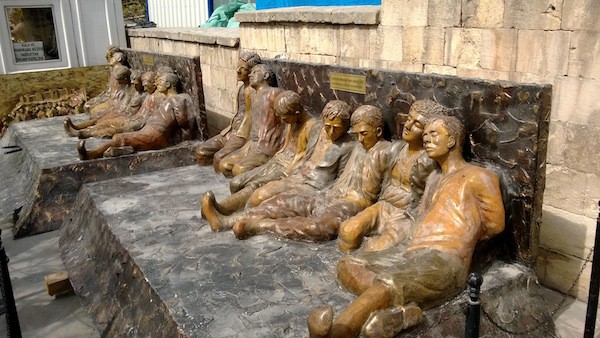
Our next stop was the City Museum, but it too was closed, swathed in scaffolding. A book that I had picked up called Changing Gaziantep showed page after page of “before” and “after” pictures, old things lovingly restored. Century-old houses and hans now converted to boutique hotels, including the one where we were staying. Kuçuk kuçuk storefronts that had been given facelifts.
After striking out twice with the castle and the City Museum, which took us to the major intersection of İstasyon, Atatürk and Hürriyet Caddeleri, we made our way back to the old town and, ducking through an archway into a courtyard, we found the Mevlevihane Museum. Inside were recreated scenes of Sufis dressed in white robes and tall hats, sitting on the floor against cushions or dancing, forever frozen mid-whirl, as well as wings for calligraphy, rugs, and textiles. Beautiful otherworldly music piped through the rooms.
The 5.5 kilometers of the so-called Culture Road in the old town are like this—winding roads that go up and down in gentle curves, stone buildings like honeycombs, and lots of color. Shops open with wooden shutters to tinkers, coppersmiths, knife-makers, cobblers, and shoe shiners. Gaziantep is a city of artisans and tradesmen from a pre-industrial time, in its old center a place not unlike the Shire in The Hobbit.
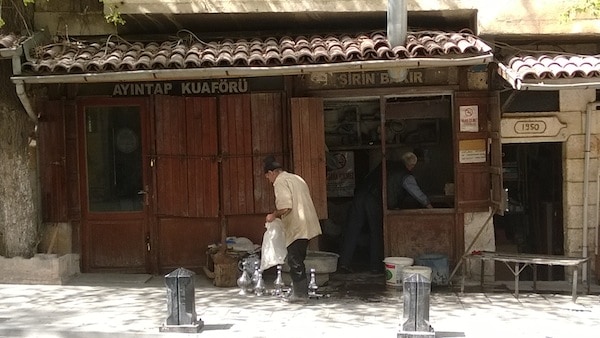
Apart from its important role as a trading post along the Silk Road, Gaziantep’s more recent honor came from enduring a 10-month siege by French forces after WWI. This is when it gained the other part of its name, gazi, meaning warrior. In the morning, we had lingered at the base of the citadel where there are bronze statues honoring those who fought and fell. They are interesting menageries. One group looks directly at the viewer, guns pointed forward. Another includes a long row of children sitting down with bowed heads titled “14 Children Martyrs”. In strange juxtaposition, there were a few local adolescent lookers in tight jeans and slick hair taking their own pictures when we took ours.
After the calming atmosphere of the Mevlevihane Museum, we sought out and found the more secular Tahmis Kahvesi, a big draw for its gorgeous interior of stained glass windows, in-laid wood, chandeliers, a ground and mezzanine level, backgammon boxes of wood and mother-of-pearl about here and there like throw pillows.
This place had been an old caravanserai, one of the many roadside inns that used to run along trade routes and an evocative place to while away an afternoon. As we approached, the door opened and a young boy in a traditional outfit with embroidered vest and fez welcomed us. Musicians flooded the high-ceilinged room ahead of us, filling it with drums and violins and flute. We ordered Turkish coffees, which came ensconced in their own silver cup-shaped boxes, and spied on the old men playing tavla and cards.
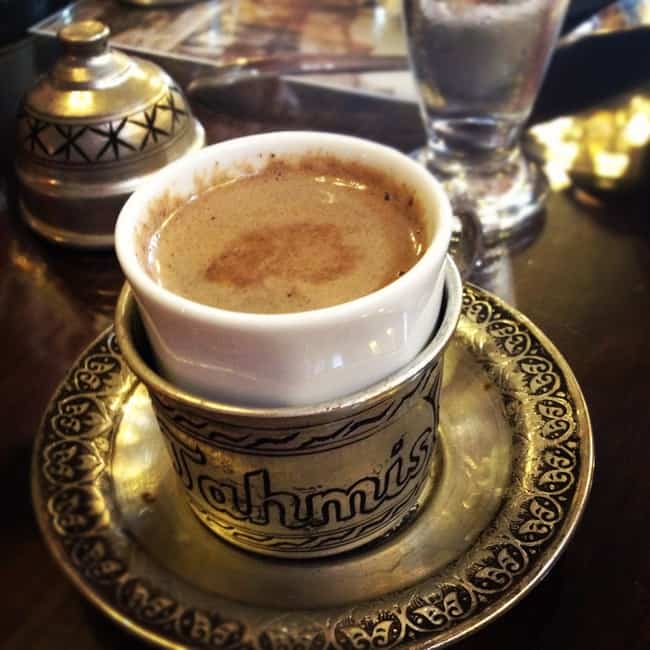
High on Turkish coffee, we then meandered into the Zincirli Bedesten, a whole maze of specialized bazaars secreted inside covered passages and decorated with streamers of peppers, dried mushrooms, and candied walnuts, almonds, pistachios, and hazelnuts. Inside this is Bakırcılar Çarşısı, the coppermakers’ bazaar, where we bought a nutcracker, a spice grinder, and a little copper pot with a handle for warming milk.
İmam Çağdaş is a sprawling two-floor restaurant and pastry shop. There we had the famed Ali Nazik kebap, a dish of melt-on-your-palate aubergine with a layer of yogurt and pieces of kebap nestled in. This was followed by little individual-sized lahmacuns, smothered in fresh-squeezed lemon, stuffed with parsley and rolled up to eat.
All day we had seen signs for the Sirehani, a beautiful historic building almost the size of an entire block and built around a vast courtyard. Now the building houses a hotel and restaurant, and the rooms that open onto the courtyard are like intricate cubbyholes with wooden doors that could seemingly be unlocked with keys used for jewelry boxes.
Tadilat and kısmet continued to guide the weekend. We spent some time searching for Papyrüs Café in a quaint back alley with lots of cafes and bars, but it was not a place for dinner. After walking in circles looking for a restaurant, we finally came back to our hotel. Kale Evi turned out to be the liveliest place on a Saturday night, thrumming with people and live traditional Turkish music played with pathos.
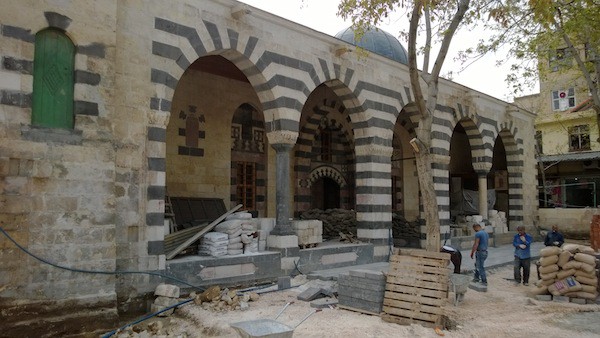
Our drive to Yorsel Mutfağa the next day again ended with a closed sign, but our taxi driver took us to Mehmet Usta Kebap instead—where we had delicious savory köfte, lamb kuşbaşı, and skewered chicken.
Despite it being Election Sunday, the Zeugma Mosaic Museum was beautifully and magnificently open. The mosaics themselves are stunning, but the space also does wonders—the modern building, soaring ceilings and dramatic lightning really fire the imagination and give a vivid sense for what the mosaics must have been like in situ.
And the Naib Hamam welcomed us as well. As it happened the temperature had dropped more than 10 degrees in the night, so while the sun was shining, there was an unseasonably icy wind, and it was just heavenly inside the bathhouse, leaning against steaming marble walls. We got scrubbed clean as babies. As we were leaving we chatted with a rosy-cheeked plump woman beside herself to practice her English and who kept saying we were “very sugar.”
Speaking of sugar, no trip to Antep would be complete without what makes it famous throughout Anatolia. That is, of course, the baklava. Be sure that all our in-between moments we were inside the sweet-stores, taste-testing baklava, chatting to the baklavacı, who described the political situation in Turkey right now as boiling and turbulent. But inside everything was calm and happy, where the holy tradition of baklava making has been going on for years—with the possible added novelty of motorbikes to deliver baklava pies like pizza. And that crackling flavorful sensation of biting into a fresh hot piece of baklava stayed long after we were on our way home.
Zamira Skalkottas is a contributor to Yabangee








